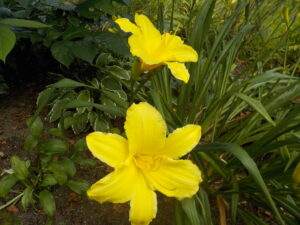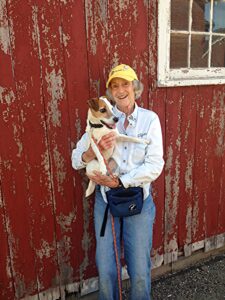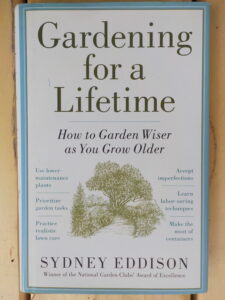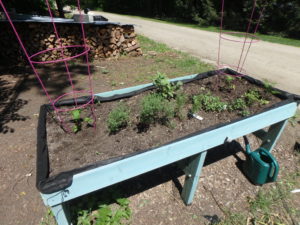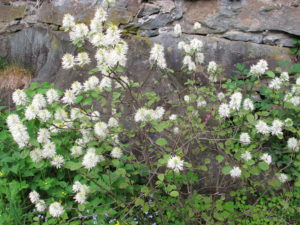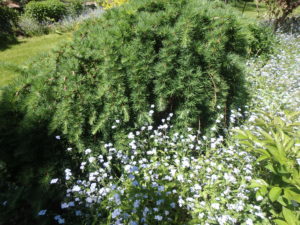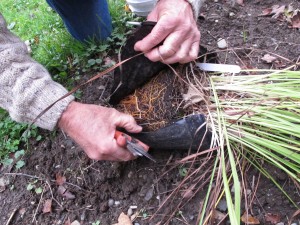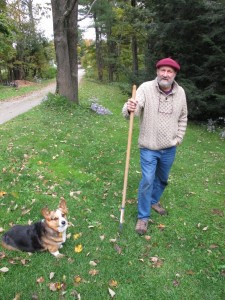Gardening Better As We Age
As a Certified Senior Citizen I sometimes wonder if I am too ambitious in my garden. I have about an acre of gardens with 200 or more kinds of flowers and a good-size vegetable garden. These gardens please me greatly, and I visit them daily all year, even in winter. In gardening season I spend considerable time weeding, pruning, mulching and admiring our gardens. I am blessed with a wife who loves to garden, and even loves weeding and edging!
Raised beds make gardening easier on us, too. I have one nice deep cedar gardening “trug” that is six-feet by two and a half-feet in size and stands 30 inches tall. I got it from Gardeners Supply several years ago and it has held up well. I grow mostly kitchen herbs in it, along with a little lettuce and a few hot peppers. It is just steps from the house, while the vegetable garden is downhill and a few hundred steps away. I might get another, or build one.
I recently called my friend Sydney Eddison at her home in Connecticut to talk about gardening as we get older. She is the author of many gardening books and a few nice small books of poetry in recent years. Her book, “Gardening for a Lifetime: How to Garden Wiser as You Grow Older” (Timber Press, 2010) if full of good ideas.
Sydney Eddison gave me good advice: if someone offers to help in the garden, accept! And if no one does offer, try to hire a younger person to help. Offer to teach them about gardening and both of you will be happy. At the end of the day sit in the garden and drink tea and eat homemade cookies. Both of you will be happy.
Gardening As We Get Older
I reached the age of 72 recently and have been thinking about the future. What will my gardens be like when I’m 82? Will I be gardening at 92? I realize I won’t always have the strength, stamina and energy to manage all I do now. Here are some thoughts about how I shall cope – and my ideas about what to do, starting now.
First, I’ll need to make choices about what flower and vegetable beds I want to keep. Growing lawn is the easiest of all gardening activities. I can see myself riding around on a mower when I can’t bend over easily to weed. And there are plenty of people who will cut the grass for a price. No special knowledge about plants is needed.
So at some point, I can let some beds revert to lawn. There are plenty of people who would be glad to come dig up and take away peonies or delphinium. If I put an announcement in the town list serve, I will find takers. Last fall I dug up some big clumps of phlox and offered them free and I found homes easily. When I want to downsize, I will make the takers do the digging!
Right now I grow 35 to 50 tomato plants a year. I start them indoors, plant them, tie them to tomato cages, cut off diseased leaves, and harvest them. Do I really need so many? We have plenty of good growers in the region, and a number of great food co-ops. I suppose in 10 years I could downsize to a dozen plants or less.
For two summers I’ve had a garden trug, a planting box on legs that I got from Gardeners Supply Company (www.gardeners.com). I have it near the front door, next to the woodpile, with quick access to the kitchen. I grow one or two tomato plants each summer there, along with plenty of lettuce and herbs. It’s waist high, so no bending is required. It’s made of cedar, and I can see using it in perpetuity. It is 6 feet long by 32 inches wide, and 16 inches deep in the middle – fine for tomatoes.
Shrubs are less work to maintain than perennials or annual flowers. Plant them, or have someone plant them, and they will require little – so long as they are not varieties that grow inordinately fast. There are plenty that can go several years without pruning.
One of my favorites is called fothergilla (Fothergilla major). It has nice white bottle-brush blossoms in May and spectacular fall foliage. Mine, after 15 years and very little pruning, is only 5 or 6 feet tall and wide. It’s hardy to Zone 4.I love my weeping larch tree (Larix laricina ‘Pendula’) that grows in a flower bed. Weepers flow and bend, but do not get tall. Mine will never get more than 3 feet tall. The foliage is soft to the touch. Larches do well in wet soils, and are quite salt tolerant.
There are, in fact, dozens of trees and shrubs sold as miniatures. Some of these are just very slow growing (like the lilac ‘Miss Kim, which can get large), while others really will never get tall, even in 25 years. These miniatures do well in flower beds.
Purple foliage is great to add color to a flower bed but I wouldn’t recommend common ninebark (Physocarpus opulifolius) ‘Diablo’ – it grows too fast and gets to be 10 feet tall before you know it. Now there are a couple of miniatures on the market, ‘Tiny Wine’ and ‘Little Devil’. I shall try one or both of those.
Of course, as we get older, it makes sense to hire some help in the garden. I have been lucky to get a teenager who not only likes being outdoors, but likes gardening and knows the difference between a weed and a flower! Even 4 hours a week makes a big difference.
If you can’t afford to have someone helping all summer, perhaps you can get someone to help clean up the gardens in spring and fall. Once beds are weeded out and mulched, the work of maintaining a garden is not too onerous – even for geezers.
I recently re-read Gardening for a Lifetime: How to Garden Wiser as You Grow Older by Sydney Eddison. Sydney is a friend of mine who lives in Connecticut, and has written many fine books. She has lots of good ideas, including the necessity to accept imperfections in the garden.
Many good gardeners are perfectionists. But as we get older, we have to accept that we can’t keep the garden perfect, or at least not without lots of help. It’s important to change one’s attitude as one ages.
Sydney also recommends getting rid of high maintenance plants and letting easy plants dominate. Daylilies, for example, have nice foliage all summer, great blossoms, and are not overly ambitious (Most don’t try to take over space allocated for other plants.) So grow plenty!
As we get older, so do our trees, creating more shade. Embrace shaded areas as weeds are sun-lovers and there are plenty of fine perennials that will do well in shade.
Some day perhaps I’ll retire and have more time for gardening. In the meantime, I’ll just try to downsize a little every year.
Follow Henry’s blog posts at https://dailyuv.com/
Gardening with Aches and Pains
As we get older, most of us develop aches and pains. As gardeners, we need to learn how to move and use our bodies so that we don’t end up feeling like a quarterback after a sacking. I love working as a garden coach, partly because I am, at heart, a school teacher; I also like finding solutions to almost anything. One of my clients, a woman with a bad shoulder, got me thinking about all the tricks I have learned over the years to minimize pain caused by gardening.
My client and I were planting some pretty big hostas. They were in large plastic pots and probably weighed about 15 pounds each. I showed her how to hold the pot upside down in one hand, and smack the bottom of the pot with the other so that the roots and soil would slide out of the pot. But with her bad shoulder, she couldn’t do that.
I taught her to cut open the pot instead. It’s a technique I use when working with trees in pots. I placed the pot on the ground and inserted the blade of my ever-present pruners into one of the drain holes at the bottom of the black plastic pot. I slit up the side to the top, and then sliced again across the bottom. Then I rolled the rootball free of the pot. Finally, I tickled the roots to loosen them up – so they will be ready to explore their new environment.
Getting down on your knees to plant anything (or to pull weeds) is tough if you have arthritic knees or hips. I can recommend a couple of ways to deal with it. My late friend Marguerite Tewksbury, a lifelong organic gardener who lived in Windsor, VT, started carrying a hoe in the garden in her late eighties. She used it not only like a walking stick, it helped her getting down – or up. By leaning on a hoe, you can distribute your weight and make a more stable, 3-point stance.
Of course I am young and healthy at 67, so I don’t need any aids getting down to weed. But sometimes at the end of the day, it’s nice to have something to lean on when on getting up. I like a 5-gallon pail for that, I can push up on it and get up more easily, with less strain on my back. Or sometimes I use my CobraHead weeder to help push me up a little.
Picking beans recently I found bending over tiresome for the length of time I needed to pick all my beans. So I used a 5-gallon pail to sit on. Gardener’s Supply (www.gardeners.com) makes something that looks very good, their “garden kneeler”; it has hand rails at the sides for getting up when kneeling or that allow you to convert it into a seat.
If you suffer from carpal tunnel, pruning may be painful for you. Most manufacturers now make hand pruners with a rotating grip that allegedly minimizes the problem. The Fiskars company has come out with a series of pruners and lopers that offer a different technology – gears to reduce the amount of pressure it takes to make a cut. I have a pair of their biggest loppers, and find them fabulous. The gears really do reduce the work of cutting larger diameter hardwood branches.
One of the most ingenious tools I ever saw used was a homemade corn planter used – and made – by a man in his 90’s. I saw him using it as I drove down the road, and I stopped to talk. He could no longer bend down to plant the seeds, so after his garden was rototilled by his son-in-law, he used a hoe to make a furrow for the seeds. Then he planted using a 30-inch piece of garden hose to get the seeds from his hand to the ground.
The hose poked up through a wide tin can (perhaps a fruit cake or cookie tin). He put all his corn seeds in the can, and then picked them up one at a time and dropped them into the hose (which poked a couple of inches into the can). Then he moved on a few inches and did it again. I’m sure that corn tasted mighty good to him, in part, because he had figured out how to keep on gardening.
Some of my friends who have moved to retirement communities keep their hand in gardening by planting in pots on a deck. Instead of 20 tomato plants, one or two in self-watering containers is what they manage. A pot roughly the size of a 5-gallon pail will do nicely for a tomato – and not have much room for weeds. Smaller pots sitting on railings can handle lettuce or basil very nicely.
If your back bothers you, be careful when hoeing or raking. Don’t lean forward. Keep your back straight. And if you need to pick up a bucket of weeds, place one foot forward and as you bend, tighten your tummy muscles.
None of us is getting any younger. But if you like gardening, you should be able to garden forever. I intend to. Please write or e-mail me if you have a good tip or trick. I’ll post them on my Web site, www.Gardening-Guy.com. Thanks.
Contact Henry at P.O. Box 364 Cornish Flat, NH 03746 or e-mailing him at henry.homeyer@comcast.net. He is the author of 4 gardening books and a recent children’s book about a boy and a cougar, Wobar and the Quest for the Magic Calumet.




